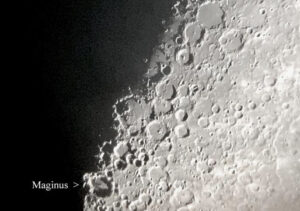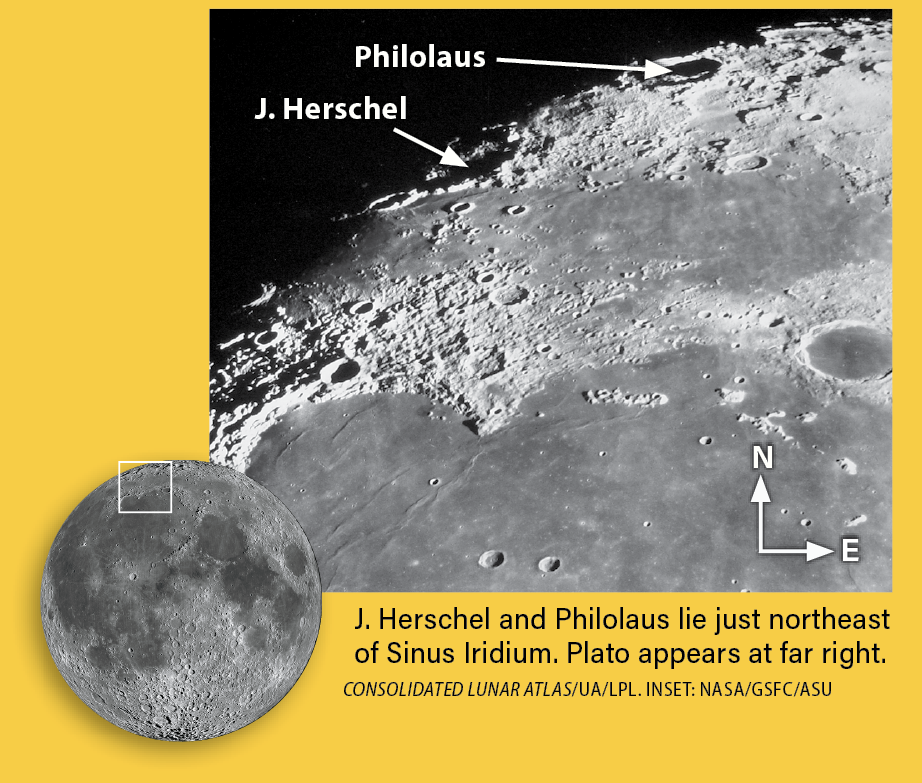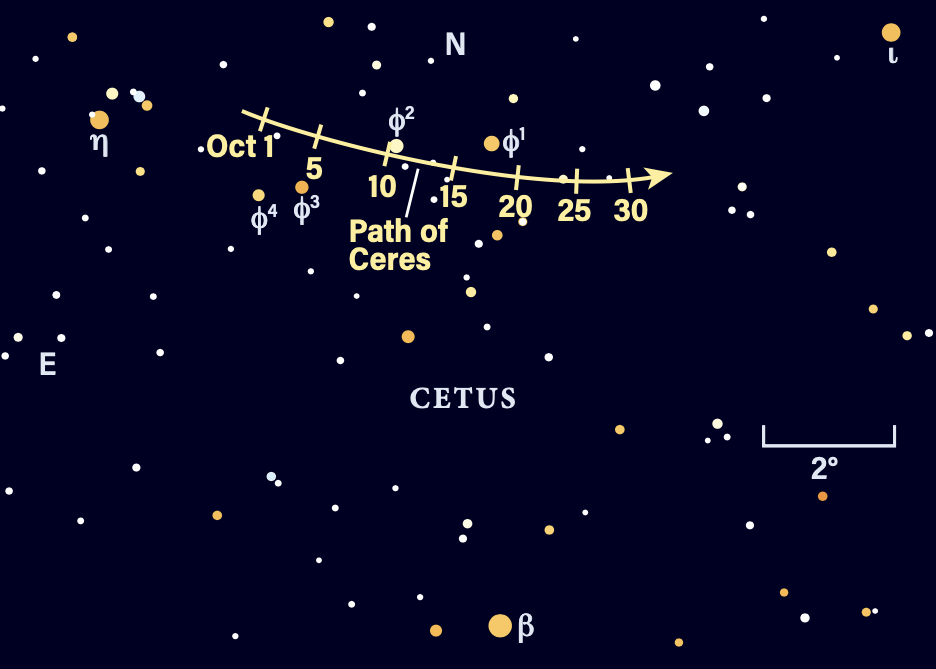Special to CosmicTribune.com, September 30, 2025
Excerpts from weekly Astronomy.com report.
Monday, September 29
First Quarter Moon occurs at 7:54 P.M. EDT, offering North American observers a chance to spot the so-called Maginus sunrise ray. Now in Sagittarius, the Moon remains above the horizon until close to midnight, offering several hours to watch the ray’s progress unfold.

The 100-mile-wide (160 km) Maginus Crater, located in the lunar south, is just seeing sunrise this evening. As the Sun slowly breaks over the crater’s eastern rim, it first spills through the divot created when a later impact blasted away part of the crater wall (resulting in the small crater Maginus E to Maginus’ east). This creates a V-shaped ray of light that spreads across the crater floor over time, illuminating a thin slice while the rest remains in shadow until the Sun breaches the top of the rim.
Because this process is slow and the Moon is above the horizon all evening, you can take your time observing it. Check in on the crater early, then spend some time with other targets. Just make sure to return to the Moon periodically throughout the night to check on the ray as it makes its way from east to west across Maginus’ floor.
Sunrise: 6:55 A.M.
Sunset: 6:45 P.M.
Moonrise: 2:35 P.M.
Moonset: 11:19 P.M.
Moon Phase: Waxing crescent (47%)
Tuesday, September 30
Saturn’s moon Iapetus is now some 8’ east of the planet; although it is nearing 12th magnitude as it approaches its fainter eastern elongation in the first week of October, observers with larger scopes may find it easier to see farther from the “noise” of the several moons that cluster closer to the ringed planet.
By 10 P.M. local daylight time, Saturn is more than 30° high in the southeast. It is the brightest point of light in this region, hanging just beneath the Circlet of Pisces. Zoom in on Saturn with a telescope and you’ll easily spot Titan, its largest and brightest moon, about 3’ east of the planet. Iapetus lies 4’ farther in the same direction, but again, it is roughly 12th magnitude (Titan is mid-8th magnitude).
Tenth-magnitude Tethys lies just west of the western edge of the rings, while Rhea lies between Titan and the eastern tip of the rings. Over the course of the night, Dione moves progressively eastward, approaching Rhea’s position early on the morning of the 1st if you follow the planet as it sinks in the west.
Mid-11th-magnitude Enceladus starts the evening on the northeastern side of the planet and passes behind it in an occultation beginning just before midnight EDT. It reappears at the northwestern limb around 2:30 A.M. EDT on the 1st.
Sunrise: 6:56 A.M.
Sunset: 6:43 P.M.
Moonrise: 3:21 P.M.
Moonset: —
Moon Phase: Waxing gibbous (57%)
Wednesday, October 1
Rising around midnight and nearly 50° high in the south two hours before sunrise is Orion the Hunter, one of autumn’s premier constellations. As the season progresses, Orion will rise earlier and earlier each night until it is visible during the evening.
For now, the best time to observe this famous star pattern is in the few hours before the Sun rises. Many observers can easily spot Orion’s three-star belt and larger hourglass figure, anchored at one shoulder by magnitude 0.5 Betelgeuse and at one knee by magnitude 0.2 Rigel. Just below the belt is the Hunter’s Sword, which contains the famous star-forming Orion Nebula, cataloged as M42.
Visible to the naked eye, this bright (magnitude 4.0) and large (85’ by 60’) nebula is one of the most popular amateur astronomy targets. You can enjoy it with binoculars or any telescope, bringing out more detail (albeit ever-smaller views) with higher magnification. At the center of the cloud of gas and dust is the Trapezium Cluster, a young open cluster of stars birthed by the nebula and whose winds are carving away a cavity within it. The brightest of the Trapezium’s stars is Theta1 (θ1) Orionis, which shines at magnitude 5.1
Take your time with this stunning target, scanning around and maybe even trying your hand at astrophotography!
The Moon passes 0.05° south of the dwarf planet Pluto at 6 P.M. EDT; neither is visible at this time. Additionally, faint Pluto will be impossible to see with the Moon nearby even after the region rises.
Sunrise: 6:57 A.M.
Sunset: 6:42 P.M.
Moonrise: 3:59 P.M.
Moonset: 12:22 A.M.
Moon Phase: Waxing gibbous (67%)

Thursday, October 2
Mercury passes 1.9° north of Spica, the brightest star in Virgo, at 7 A.M. EDT. The pair is unfortunately quite close to the Sun and disappears beneath the western horizon only 20 minutes after sunset, rendering them effectively invisible for most observers. Mercury’s visibility will improve later this month, so we’ll return to the solar system’s smallest planet soon.
Dwarf planet 1 Ceres is at opposition at 9 A.M. EDT. The most massive body in the main belt is visible most of the night, rising around sunset and setting around sunrise in the constellation Cetus. We’ll return to this target tomorrow night.
Tonight we’re back at the Moon to catch sunrise as it finally starts to reach the northwestern portions of the nearside. Use the accompanying chart and a telescope to locate a pair of craters near the terminator: J. Herschel and Philolaus. The former is larger, spanning 96 miles (154 km). You can also tell it is older by looking at its rim, which has been significantly battered down over the ages. The floor is buried in rubble, diminishing the visibility of its central peaks.
Northeast of J. Herschel is Philolaus, which spans some 44 miles (71 km) and features a much sharper rim, indicating it is younger (i.e., less battered). It has two central peaks, which may be difficult to make out tonight but will appear over the next few nights, even as J. Herschel’s features also change under the rising Sun.
Sunrise: 6:58 A.M.
Sunset: 6:40 P.M.
Moonrise: 4:31 P.M.
Moonset: 1:30 A.M.
Moon Phase: Waxing gibbous (76%)

Friday, October 3
Now let’s peer into Cetus the Whale to spot 1 Ceres this evening, one day past opposition and glowing at magnitude 7.6, within the reach of binoculars or any small scope.
Ceres is carving a slow path north of Diphda, Cetus’ magnitude 2.0 beta star. Around 10 P.M. local daylight time, Diphda is roughly 20° high in the southeast and Ceres lies just over 8° north of this star. As you skim north of Diphda, you’ll pass a chain of four 5th- to 6th-magnitude stars, strung roughly east to west. From west to east, these are Phi1, Phi2, Phi3, and Phi4 Ceti; Ceres is now just about 1° due north of magnitude 5.4 Phi3.
You can use this same string of stars to chart Ceres’ movement throughout the month, as it passes close to Phi2 on the 10th and hangs due south of Phi1 on the 18th.

You must be logged in to post a comment Login